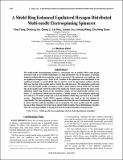A shield ring enhanced equilateral hexagon distributed multi-needle electrospinning spinneret
Author(s)
Yang, Ying; Jia, Zhidong; Li, Qiang; Hou, Lei; Liu, Jianan; Wang, Liming; Guan, Zhicheng; Zahn, Markus; ... Show more Show less
DownloadZahn_A shield ring.pdf (1.163Mb)
PUBLISHER_POLICY
Publisher Policy
Article is made available in accordance with the publisher's policy and may be subject to US copyright law. Please refer to the publisher's site for terms of use.
Terms of use
Metadata
Show full item recordAbstract
The multi-needle electrospinning system is a convenient way to produce fibers with special structures such as core-shell morphologies at a high production rate. In this paper, a specially designed multi-needle electrospinning system is presented. The spinnerets were built-up with an equilateral hexagon array. Each set of 3 needles of the spinnerets were distributed as an equilateral triangle. A coaxial shield ring was used to create an approximate uniform electric field near the tips of the needles and to restrict the collection area. The simulation results also show that the outside needles can help to create a more uniform electric field near the inside tips of the needles and restrict the path of the inside jets, which works almost the same as the additional shield ring. Based on the simulation results, several multi-needle systems were tested. A 7 cm diameter shield ring was used in a 7 needle system, a 9 cm diameter shield ring was used in a 19 needle system and a 10.5 cm diameter shield ring was used in a 37 needle system. Polyethylene Oxide (PEO) aqueous solution was used as the test solution in experiments. The electrospinning results demonstrated that the use of multi-needle spinnerets is robust and that uniform nanofibers can be produced. The more needles used, the smaller the mean fiber diameter for larger mean electric field strengths. These distributions of needles show the scale up possibility of special structure electrospun nanofiber manufacturing.
Date issued
2010-10Department
Massachusetts Institute of Technology. Department of Electrical Engineering and Computer Science; Massachusetts Institute of Technology. High Voltage Research Laboratory; Massachusetts Institute of Technology. Laboratory for Electromagnetic and Electronic Systems; Massachusetts Institute of Technology. Research Laboratory of ElectronicsJournal
IEEE Transactions on Dielectrics and Electrical Insulation
Publisher
Institute of Electrical and Electronics Engineers (IEEE)
Citation
Yang, Ying et al. “A Shield Ring Enhanced Equilateral Hexagon Distributed Multi-needle Electrospinning Spinneret.” IEEE Transactions on Dielectrics and Electrical Insulation 17.5 (2010): 1592–1601. © 2010 IEEE.
Version: Final published version
ISSN
1070-9878